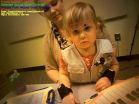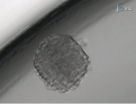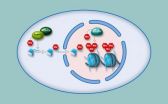(Press-News.org) Researchers in Georgia Tech's Center for Behavior Imaging have developed two new technological tools that automatically measure relevant behaviors of children, and promise to have significant impact on the understanding of behavioral disorders such as autism.
One of the tools—a system that uses special gaze-tracking glasses and facial-analysis software to identify when a child makes eye contact with the glasses-wearer—was created by combining two existing technologies to develop a novel capability of automatic detection of eye contact. The other is a wearable system that uses accelerometers to monitor and categorize problem behaviors in children with behavioral disorders.
Both technologies already are being deployed in the Center for Behavior Imaging's (CBI) ongoing work to apply computational methods to screening, measurement and understanding of autism and other behavioral disorders.
Children at risk for autism often display distinct behavioral markers from a very young age. One such marker is a reluctance to make frequent or prolonged eye contact with other people. Discovering an automated way to detect this and other telltale behavioral markers would be a significant step toward scaling autism screening up to much larger populations than are currently reached. This is one goal of the five-year, $10 million "Expeditions" project, funded in fall 2010 by the National Science Foundation under principal investigator and CBI Director Jim Rehg, also a professor in Georgia Tech's School of Interactive Computing.
The eye-contact tracking system begins with a commercially available pair of glasses that can record the focal point of their wearer's gaze. Researchers took video of a child captured by a front-facing camera on the glasses, worn by an adult who was interacting with the child. The video was then processed using facial recognition software available from a second manufacturer. Combine the glasses' hard-wired ability to detect wearer gaze with the facial-recognition software's ability to detect the child's gaze direction, and the result is a system able to detect eye contact in a test interaction with a 22-month-old with 80 percent accuracy. The study was conducted in Georgia Tech's Child Study Lab (CSL), a child-friendly experimental facility richly equipped with cameras, microphones and other sensors.
"Eye gaze has been a tricky thing to measure in laboratory settings, and typically it's very labor-intensive, involving hours and hours of looking at frames of video to pinpoint moments of eye contact," Rehg said. "The exciting thing about our method is that it can produce these measures automatically and could be used in the future to measure eye contact outside the laboratory setting. We call these results preliminary because they were obtained from a single subject, but all humans' eyes work pretty much the same way, so we're confident the successful results will be replicated with future subjects."
The other new system, developed in collaboration with the Marcus Autism Center in Atlanta and Dr. Thomas Ploetz of Newcastle University in the United Kingdom, is a package of sensors, worn via straps on the wrists and ankles, that uses accelerometers to detect movement by the wearer. Algorithms developed by the team analyze the sensor data to automatically detect episodes of problem behavior and classify them as aggressive, self-injurious or disruptive (e.g., throwing objects).
Researchers first developed the algorithms by putting the sensors on four Marcus clinic staff members who together performed some 1,200 different behavior instances, and the system detected "problem" behaviors with 95 percent accuracy and classified all behaviors with 80 percent accuracy. They then used the sensors with a child diagnosed along the autism spectrum, and the system detected the child's problem-behavior episodes with 81 percent accuracy and classified them with 70 percent accuracy.
"These results are very promising in leading the way toward more accurate and reliable measurement of problem behavior, which is important in determining whether treatments targeting these behaviors are working," said CSL Director Agata Rozga, a research scientist in the School of Interactive Computing and co-investigator on the Expeditions award. "Our ultimate goal with this wearable sensing system is to be able to gather data on the child's behavior beyond the clinic, in settings where the child spends most of their time, such as their home or school. In this way, parents, teachers and others who care for the child can be potentially alerted to times and situations when problem behaviors occur so that they can address them immediately."
"What these tools show is that computational methods and technologies have great promise and potential impact on the lives of many children and their parents and caregivers," said Gregory Abowd, Regents' Professor in the School of Interactive Computing and a prominent researcher in technology and autism. "These technologies we are developing, and others developed and explored elsewhere, aim to bring more effective early-childhood screening to millions of children nationwide, as well as enhance care for those children already diagnosed on the autism spectrum."
Both technologies were presented in early September at the 14th ACM International Conference on Ubiquitous Computing (Ubicomp 2012). Among the other devices under study at CSL are a camera/software system that can track children's facial expressions and customized speech analysis software to detect vocalization patterns.
INFORMATION:
For more information on behavioral imaging, visit the Georgia Tech/NSF website on computational behavioral science at http://www.cbs.gatech.edu.
For information or to volunteer for one of CBI's ongoing studies, visit the Child Study Lab website at http://childstudy.hsi.gatech.edu.
Georgia Tech creating high-tech tools to study autism
Innovations will lead to better treatment, assessment for children
2012-09-25
ELSE PRESS RELEASES FROM THIS DATE:
After a 2-year slowdown, health spending grew 4.6 percent per capita in 2011, says HCCI report
2012-09-25
Washington, DC—U.S. health care spending grew at a faster pace than expected in 2011,
according to a new report from the Health Care Cost Institute (HCCI). The Health Care Cost and
Utilization Report: 2011 provides the first broad look at 2011 health care spending among those
with employer-sponsored insurance (ESI). HCCI found that average dollars spent on health care
services for that population climbed 4.6 percent in 2011, reaching $4,547 per person. This was
well above the 3.8 percent growth rate observed in 2010 and beyond expected growth for
2011.
Consumers ...
Language use is simpler than previously thought, finds Cornell study
2012-09-25
ITHACA, N.Y. — For more than 50 years, language scientists have assumed that sentence structure is fundamentally hierarchical, made up of small parts in turn made of smaller parts, like Russian nesting dolls. But a new Cornell University study suggests language use is simpler than they had thought.
Co-author Morten Christiansen, Cornell professor of psychology and co-director of the Cornell Cognitive Science Program, and his colleagues say that language is actually based on simpler sequential structures, like clusters of beads on a string.
"What we're suggesting is ...
Study of cigarette and waterpipe tobacco smoking shows knowledge gap in perceived health risks
2012-09-25
RICHMOND, Va. (Sept. 25, 2012) – People who smoke both cigarettes and waterpipes – dual users – lack sufficient knowledge about the risks of tobacco smoking and are at considerable risk for dependence and tobacco-related diseases, such as cancer, heart disease and stroke later in life, according to findings of a new study by Virginia Commonwealth University.
The study, the first of its kind to assess trends in cigarette and waterpipe tobacco smoke based on long-term data, reveals few users perceive dangers of waterpipe tobacco. A common misconception about waterpipe ...
Mechanism that leads to sporadic Parkinson's disease identified
2012-09-25
New York, NY (September 25, 2012) — Researchers in the Taub Institute at Columbia University Medical Center (CUMC) have identified a mechanism that appears to underlie the common sporadic (non-familial) form of Parkinson's disease, the progressive movement disorder. The discovery highlights potential new therapeutic targets for Parkinson's and could lead to a blood test for the disease. The study, based mainly on analysis of human brain tissue, was published today in the online edition of Nature Communications'.
Studies of rare, familial (heritable) forms of Parkinson's ...
News consumption of political stories not enough to retain political knowledge
2012-09-25
A strong democracy depends on smart voters who choose their leaders based on their knowledge of important political issues. One of the ways that Americans learn about politics is by following the news. Now, researchers from the University of Missouri School of Journalism have found that simply following the news is not enough.
A panel survey involving more than 1,200 teenagers from 12 to 17 years of age found that adolescents learn more about politics when they think and talk about what they read or watch on the news. Edson Tandoc, a doctoral student at MU, found that ...
JoVE article shows steps to isolate stem cells from brain tumors
2012-09-25
September 25, 2012
A new video protocol in Journal of Visualized Experiments (JoVE) details an assay to identify brain tumor initiating stem cells from primary brain tumors. Through flow cytometry, scientists separate stem cells from the rest of the tumor, allowing quick and efficient analysis of target cells. This approach has been effectively used to identify similar stem cells in leukemia patients.
"Overall, these tumors are extremely rare, with only around one in 100,000 people being diagnosed with a primary brain cancer," Dr. Sheila Singh, co-author and neurosurgeon ...
Making and breaking heterochromatin
2012-09-25
This press release is available in German.
To fit the two-meter long DNA molecule into a cell nucleus that is only a few thousandths of a millimetre in size, long sections of the DNA must be strongly compacted. Epigenetic marks maintain these sections, known as heterochromatin. Scientists of the Max Planck Institute of Immunobiology and Epigenetics in Freiburg have now discovered two further mechanisms necessary for the formation of heterochromatin. The research group, led by Thomas Jenuwein, describes two novel enzymes, Prdm3 and Prdm16, which attach a methyl group to ...
Treatment for alcoholism dramatically reduces the financial burden of addiction on families
2012-09-25
The financial effects of alcoholism on the family members of addicts can be massive, but little is known about whether treatment for alcoholism reduces that financial burden. A study of 48 German families published online today in the journal Addiction reveals that after twelve months of treatment, family costs directly related to a family member's alcoholism decreased from an average of €676.44 (£529.91, US$832.26) per month to an average of €145.40 (£113.90, $178.89) per month. Put another way, average costs attributable to alcoholism decreased from 20.2% to 4.3% of ...
Model confirms active surveillance as viable option for men with low-risk prostate cancer
2012-09-25
PHILADELPHIA — A new research model has estimated that the difference in prostate cancer mortality among men with low-risk disease who choose active surveillance versus those who choose immediate treatment with radical prostatectomy is likely to be very modest, possibly as little as two to three months.
The model, developed by biostatistician Ruth Etzioni, Ph.D., and colleagues of the Public Health Sciences Division at Fred Hutchinson Cancer Research Center in Seattle, Wash., is among the first to use specific data from published studies to project the likelihood of ...
Video: 3-D time-lapse imaging captures twisted root mechanics for first time
2012-09-25
ITHACA, N.Y. — Using an advanced 3-D time-lapse imaging system, a group of physicists and plant biologists from Cornell University and the Boyce Thompson Institute for Plant Research have discovered how certain plant roots exhibit powerful mechanical abilities while navigating their environment.
The research, published in this week's online Early Edition of Proceedings of the National Academy of Sciences, could eventually assist in breeding crop plants optimized for growth in areas where climate change or over farming has led to difficult soil conditions (study: http://bit.ly/OaG2A5).
The ...
LAST 30 PRESS RELEASES:
Eye for trouble: Automated counting for chromosome issues under the microscope
The vast majority of US rivers lack any protections from human activities, new research finds
Ultrasound-responsive in situ antigen "nanocatchers" open a new paradigm for personalized tumor immunotherapy
Environmental “superbugs” in our rivers and soils: new one health review warns of growing antimicrobial resistance crisis
Triple threat in greenhouse farming: how heavy metals, microplastics, and antibiotic resistance genes unite to challenge sustainable food production
Earthworms turn manure into a powerful tool against antibiotic resistance
AI turns water into an early warning network for hidden biological pollutants
Hidden hotspots on “green” plastics: biodegradable and conventional plastics shape very different antibiotic resistance risks in river microbiomes
Engineered biochar enzyme system clears toxic phenolic acids and restores pepper seed germination in continuous cropping soils
Retail therapy fail? Online shopping linked to stress, says study
How well-meaning allies can increase stress for marginalized people
Commercially viable biomanufacturing: designer yeast turns sugar into lucrative chemical 3-HP
Control valve discovered in gut’s plumbing system
George Mason University leads phase 2 clinical trial for pill to help maintain weight loss after GLP-1s
Hop to it: research from Shedd Aquarium tracks conch movement to set new conservation guidance
Weight loss drugs and bariatric surgery improve the body’s fat ‘balance:’ study
The Age of Fishes began with mass death
TB harnesses part of immune defense system to cause infection
Important new source of oxidation in the atmosphere found
A tug-of-war explains a decades-old question about how bacteria swim
Strengthened immune defense against cancer
Engineering the development of the pancreas
The Journal of Nuclear Medicine ahead-of-print tip sheet: Jan. 9, 2026
Mount Sinai researchers help create largest immune cell atlas of bone marrow in multiple myeloma patients
Why it is so hard to get started on an unpleasant task: Scientists identify a “motivation brake”
Body composition changes after bariatric surgery or treatment with GLP-1 receptor agonists
Targeted regulation of abortion providers laws and pregnancies conceived through fertility treatment
Press registration is now open for the 2026 ACMG Annual Clinical Genetics Meeting
Understanding sex-based differences and the role of bone morphogenetic protein signaling in Alzheimer’s disease
Breakthrough in thin-film electrolytes pushes solid oxide fuel cells forward
[Press-News.org] Georgia Tech creating high-tech tools to study autismInnovations will lead to better treatment, assessment for children


